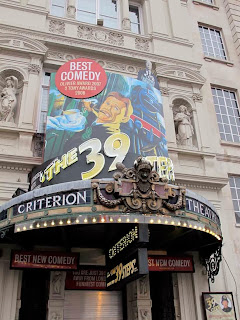Piccadilly Circus connects to Piccadilly, a thoroughfare whose name first appeared in 1626 as Piccadilly Hall, named after a house belonging to one Robert Baker, a tailor famous for selling piccadills, or piccadillies, a term used for various kinds of collars. The street was known as Portugal Street in 1692 in honour of Cathrine of Braganza, the queen consort of King Charles II of England but was known as Piccadilly by 1743. Piccadilly Circus was created in 1819, at the junction with Regent street, which was then being built under the planning of John Nash on the site of a house and garden belonging to a Lady Hutton. The circus lost its circular form in 1886 with the construction of Shaftesbury Avenue.
The junction has been a very busy traffic interchange since construction, as it lies at the centre of Theatreland and handles exit traffic from Piccadilly, which Charle Dickens Jr. described in 1879: "Piccadilly, the great thoroughfare leading from the Haymarket and Regent street westward to Hyde-Park Corner, is the nearest approach to the Parisian boulevard of which London can boast."
The Piccadilly Circus tube station was opened 10 March 1906, on the Bakerloo Line, and on the Piccadilly line in December of that year. In 1928, the station was extensively rebuilt to handle an increase in traffic. The intersection's first electric advertisements appeared in 1910, and, from 1923, electric billboards were set up on the facade of the London Pavilion. Traffic lights were first installed on 3 August 1926, at the junction.
During World War II many servicemen's clubs in the West End served American soldiers based in Britain. So many prostitutes roamed the area approaching the soldiers that they received the nickname "Piccadilly Commandos", and both Scotland Yard and the Foreign office discussed possible damage to Anglo-American relations.
At the start of the 1960s, it was determined that the Circus needed to be redeveloped to allow for greater traffic flow. In 1962, Lord Holford presented a plan which would have created a "double-decker" Piccadilly Circus; the upper deck would have been an elevated pedestrian concourse linking the buildings around the perimeter of the Circus, with the lower deck being solely for traffic, most of the ground-level pedestrian areas having been removed to allow for greater vehicle flow. This concept was kept alive throughout the rest of the 1960s. A final scheme in 1972 proposed three octagonal towers (the highest 240 feet (73 m) tall) to replace the Trocadero, the Criterion and the "Monico" buildings. The plans were permanently rejected by Sir Keith Joseph and Ernest Marples; the key reason given was that Holford's scheme only allowed for a 20% increase in traffic, and the Government required 50%.
The Shaftesbury Memorial Fountain in Piccadilly Circus was erected in 1893 to commemorate the philanthropic works of Anthony Ashley Copper, 7th Earl of Shaftesbury. During the Second World War, the statue atop the Shaftesbury Memorial Fountain was removed and was replaced by advertising hoardings. It was returned in 1948. When the Circus underwent reconstruction work in the late 1980s, the entire fountain was moved from the centre of the junction at the beginning of Shaftesbury Avenue to its present position at the southwestern corner.














No comments:
Post a Comment